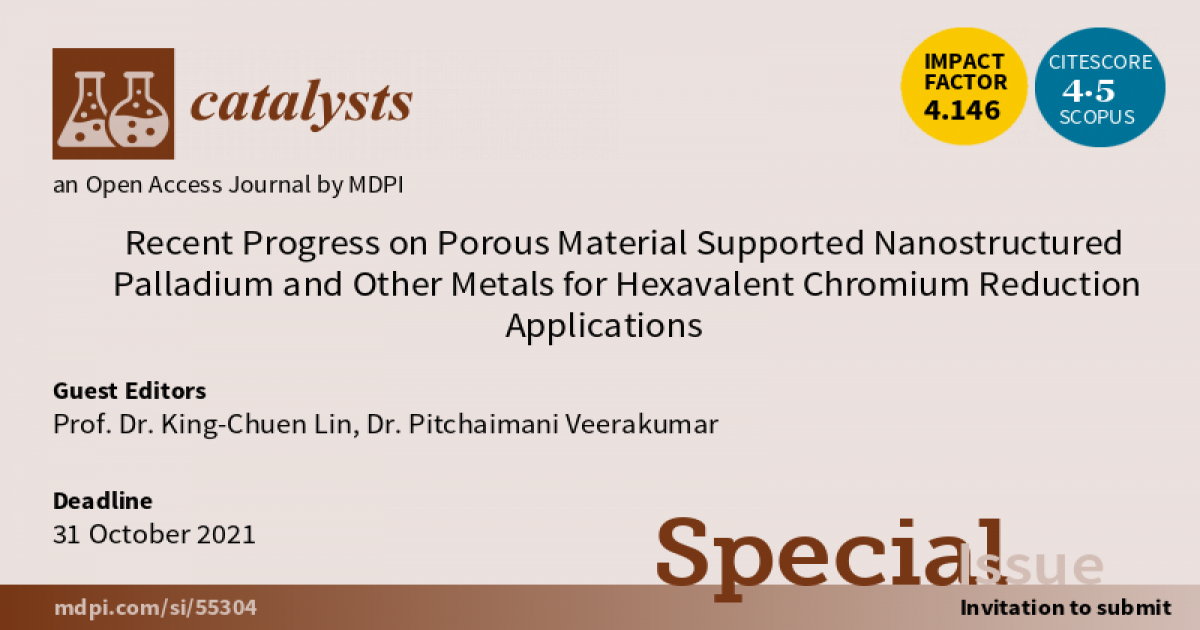Recent Progress on Porous Material Supported Nanostructured Palladium and Other Metals for Hexavalent Chromium Reduction Applications
A special issue of Catalysts (ISSN 2073-4344). This special issue belongs to the section "Nanostructured Catalysts".
Deadline for manuscript submissions: closed (31 October 2021) | Viewed by 839

Special Issue Editors
Interests: metal nanoparticles; energy storage; sensors; solid nanocatalysts
Interests: nanocatalysis; supercapacitors; electrochemical sensors; energy conversion; metal-free catalysts
Special Issues, Collections and Topics in MDPI journals
Special Issue Information
Dear Colleagues,
In recent years, porous carbon has gained considerable attention because of its well-developed pore structure, high surface area, and surface chemical functional groups. Hexavalent chromium is extremely toxic and increasingly prevalent owing to industrialization, thereby, posing serious human health and environmental risks. Therefore, new approaches for the reduction of high concentrations of Cr(VI) using an ultralow amount of palladium nanoparticles (Pd NPs) or other effective metal nanoparticles supported by carbon-based heterogeneous catalysts with high recyclability are increasingly being considered. Metal nanoparticles can now be prepared with greater precision via various chemical reduction processes, which often serve as active catalytic components, can be synthesized in a more environmentally friendly manner with well-defined sizes, shapes, crystal facets, structure, and composition. In addition, we hope to address recent progress in an environmentally friendly and cost-effective approach for the synthesis routes of mono-, bi-, and multi-metallic (Pd or other metal) nanoparticle-supported carbon catalysts including graphene-based materials, carbon nanotubes, mesoporous carbons, activated carbons, and so forth. Among a variety of different rare earth and transition metals, palladium-based nanocatalysts have been extensively studied both in academia and in industry because of their applications, such as in carbon-carbon cross-coupling, carbon-carbon homocoupling, carbon-heteroatom cross-coupling reactions, as well as C-H activation, hydrogenation, esterification, oxidation, and reduction. The related mechanisms for the Cr(VI) reduction in the different reducing agents should be also suggested. Recently, some reports demonstrate that the Pd NPs/carbon nanocomposite catalyst exhibited a high Cr(VI) reduction activity and maintained a high reduction rate over multiple catalytic cycles. It was concluded that the immobilization of functional materials in proper support can distinctly improve catalytic activity. Thus, this Special Issue provides new insights into the catalytic reduction of Cr(VI) for wastewater treatment. Moreover, the current issue will highlight the recent developments in the synthesis and characterization of palladium or other metal/carbon nanocatalysts used for the reduction of Cr(VI).
This Special Issue will cover the most recent progress and the advances in the field of the different Pd or other metal NPs/carbon nanocomposites that are of importance to the reduction of Cr(VI). In the current research and development scenario, the viewer can easily grasp the fundamentals of the preparation route, mechanisms, and advantages of these metal nanocomposites. Finally, recent challenges related to advanced Pd or other metal-based carbon nanomaterials and perspective will be discussed in this issue.
Prof. Dr. King-Chuen Lin
Dr. Pitchaimani Veerakumar
Guest Editors
Manuscript Submission Information
Manuscripts should be submitted online at www.mdpi.com by registering and logging in to this website. Once you are registered, click here to go to the submission form. Manuscripts can be submitted until the deadline. All submissions that pass pre-check are peer-reviewed. Accepted papers will be published continuously in the journal (as soon as accepted) and will be listed together on the special issue website. Research articles, review articles as well as short communications are invited. For planned papers, a title and short abstract (about 100 words) can be sent to the Editorial Office for announcement on this website.
Submitted manuscripts should not have been published previously, nor be under consideration for publication elsewhere (except conference proceedings papers). All manuscripts are thoroughly refereed through a single-blind peer-review process. A guide for authors and other relevant information for submission of manuscripts is available on the Instructions for Authors page. Catalysts is an international peer-reviewed open access monthly journal published by MDPI.
Please visit the Instructions for Authors page before submitting a manuscript. The Article Processing Charge (APC) for publication in this open access journal is 2700 CHF (Swiss Francs). Submitted papers should be well formatted and use good English. Authors may use MDPI's English editing service prior to publication or during author revisions.
Keywords
- Palladium
- Metal nanoparticles
- Hexavalent chromium
- Porous carbons
- Heterogeneous catalysis
- Supported catalysts
- Sustainable nanocatalysts






